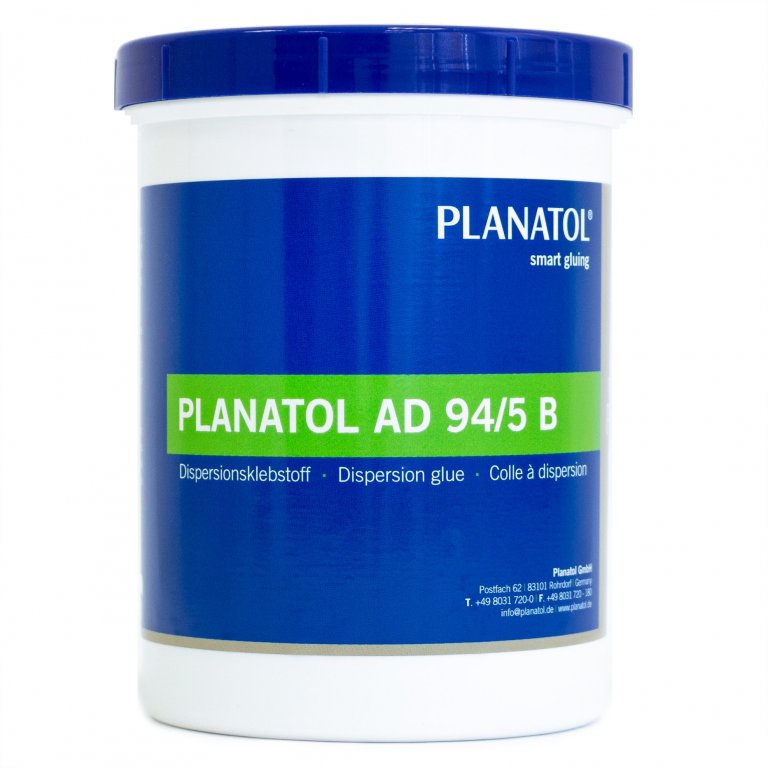
Planatol bookbinding glue AD 94/5 B
| Location in Store | EGI22A |
|---|---|
| Article No. | 0190627 |
synthetic dispersion adhesive for cardboard, paperboard, paper, plastic and problematic materials, pH value approx. 5, translucent when set, flexible, moisture-proof, aging-resistant
Planatol bookbinding glue is a special adhesive for gluing paper, cardboard and paperboard. Depending on the job, it can be used unthinned or thinned or mixed with starch paste or cellulose paste. The mixing of bookbinding glue and paste glue produces an adhesive that is excellent to work with: even a small amount of bookbinding glue has the effect of making the paste glue insoluble, of making it become sticky more quickly and of preventing the material being worked on from becoming warped or wavy. It is also true in the reverse: bookbinding glue is a lot easier to spread if a small amount of paste glue is added to it: it dries more slowly and the bonding of the work pieces also takes place more slowly. Paste glue can be used as a thinner instead of water.
The bonding of paper materials with aqueous adhesives – especially surface layer bonding – is not an easy matter but, when done properly, it does produce very nice results. There is always the danger, however, that layouts or posters will end up being glued to what have become irreparably wavy or warped carrier materials if you are not careful. There is an excellent introduction to the techniques of bookbinding written by Franz Zeier called Books, Boxes & Portfolios (in our shop in German but available in English as well in the internet). Our chart depicting the possible uses of various adhesive mixtures and the best mixing ratios for certain jobs is based on this book.
FYI: there is a simple recipe, which is described by Franz Zeier, for making starch paste yourself using wheat starch flour. Cellulose paste glue, which can also be used for thinning Planatol BB, is basically just our Wallpaper paste.
Attributes: Planatol AD 94/5 B is an aqueous, high viscosity dispersion glue that has many uses and which, because of its excellent adhesion, is especially effective on demanding surfaces. It becomes sticky quickly and cures to a translucent, moisture proof and flexible film that retains a slight stickiness even when completely dry.
Application: Planatol AD 94/5 B is not only good for gluing paper and cardboard but markedly smooth surfaces like aluminium foil, glass and many plastic films (acetate, cellophane, soft and rigid PVC, polystyrene foam...) as well. In addition, it works great when gluing painted and laminated surfaces to absorbent materials like paper, paperboard, cardboard, felt, fabric, leather, fibre board, foamed cellular material, fleece, etc. You can also glue PE paper photographs to cardboard, plywood or chipboard. It should not be used, however, for gluing untreated PP or PE films. This glue can be used for practically every bonding need when doing a bookbinding project.
Treatment: Planatol AD 94/5 B is machine-ready but good results can also be attained by hand application. If necessary, water can be used as a thinner. Tools can be cleaned with cold water after use. It is recommended that the product be used within six months.
Application possibilities for adhesive mixtures:
| Application | Glue type | Paste glue | Bookbinding glue |
| Thin paper on paper, paperboard, cardboard | Starch paste glue | 100 % | - |
| Medium thick paper (80 - 120 g/m²) on paper, paperboard, cardboard | Planatol Elasta N + starch or cellulose paste glue | 4 parts | 1 part |
| Thick paper (120 - 150 g/m²) and book cover fabric on cardboard | Planatol Elasta N + starch or cellulose paste glue | 1 part | 1 part |
| Thin paperboard (150 – 300 g/m²) on paperboard, cardboard, wood | Planatol BB/Elasta N + starch or cellulose paste glue | 1 part | 4 parts |
|
Paperboard and cardboard on paperboard and cardboard |
Planatol BB | - | 100 % |
| Paper, paperboard, cardboard on plastic and smooth surfaces | Planatol AD 94/5 B | - | 100 % |
| Large photos (normal paper) on cardboard, fabric, plywood, chip board | Planatol Elasta N | - | 100 % (wet the backside of photos with water) |
| Large photos (PE paper) on cardboard, plywood, fibreboard, chip board (also plastic coated) | Planatol AD 94/5 B | - | 100 % |
Free standard delivery within Germany and free collection from Modulor in Berlin for orders over 89 €.
5,95 € shipping costs, if order value is less than 89 € (DE)
2,95 € for pick-up at the store in Berlin, if order value is less than 89 €
Express and forwarding shipping
From 19 € express surcharge you will receive your order particularly quickly with standard shipping within Germany.
From 69€ is the cost of shipping within Germany. You can recognize articles with forwarding shipping in the store by the truck symbol .
Especially for Berlin
From 34.90 € courier shipping for standard and forwarding goods.
- Free returns for standard shipping within Germany
- Extended, voluntary return policy of 30 days for complete, undamaged goods in their original packaging
- You are responsible for the cost of returns for forwarding goods and returns from a country outside Germany
Excluded from returns
Excluded from returns are sections of rolled goods, cut-to-size pieces and other goods made especially for you, as well as used goods, newspapers, magazines and periodicals, Modulor vouchers and items that we do not carry in our range but have ordered at your request.
Good to know: The furniture variants in our configurators that can be delivered quickly are not cut to size, but standard formats that can be returned.
Ludwig-Weis-Str. 11
97082 Würzburg
Germany
info@sprintis.de